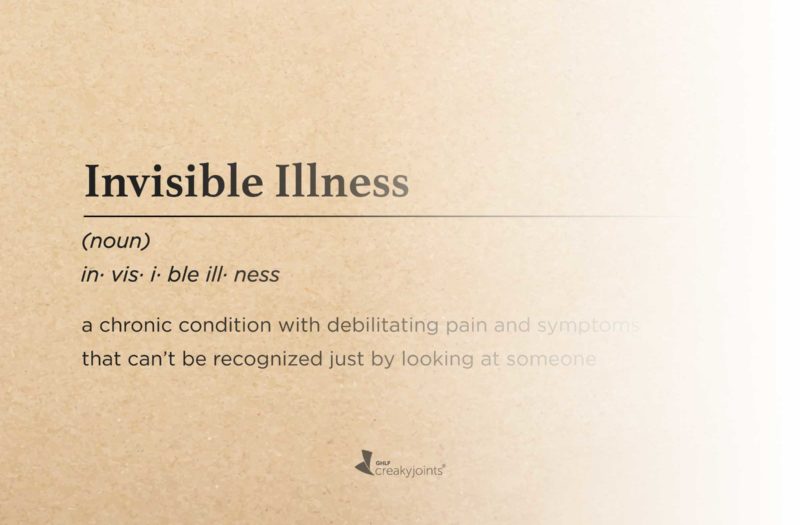Having an invisible illness that causes chronic pain, like rheumatoid arthritis, lupus, or axial spondyloarthritis, comes with a long list of burdens. There are the physical burdens, like the stiff, swollen joints that prevent you from ever feeling comfortable and the 24/7 fatigue that keeps you in bed. There are the emotional burdens, such as sadness over how your life has changed since being diagnosed and anxiety over how your illness may progress over time. And then there is a burden that takes a physical, emotional, and mental toll: the constant challenge of explaining your illness to others.
Telling — or, more accurately, teaching — people about an invisible illness can be challenging. Because, as the name implies, it can’t be seen by others. Unlike a broken bone, where people can see evidence of the injury and pain, an invisible illness does internal damage, and its symptoms hide beneath the surface. Not to mention many invisible illnesses are, well, complicated. Even medical experts can be stumped by the challenges an invisible illness can present.
Of course, sometimes chronic pain is visible. Your gait may change if you have bad arthritis in your hip, say. You could get psoriasis or lupus rashes on your skin. But in general, rheumatic diseases are invisible relative to how much pain, disability, and long-term damage they cause.
Still, telling others about your lived experience with an invisible illness is important. It allows people to better understand your situation, which (hopefully) allows them to make helpful adjustments and offer empathy. It also helps raise awareness which, in turn, can lead to changes that improve the care and quality of life for those living with invisible illnesses.
As part of Arthritis Awareness Month, we asked members of our community how they explain their invisible illness to others. It seems that people have different approaches when trying to teach others about their conditions. Some, like Julie M., compare it to “having the flu every day.” Others, like manasi_i, tell people that “my body is treating itself as an enemy.” One person, Luzsanti, describes their illness as, “the kind of tired and the kind of pain that can knock you out even when you think you are prepared for it.”
But several members of our community shared a sad truth: they don’t even try to explain their condition to others. For many of them, trying to get others to understand an invisible illness can be practically as draining as the illness itself.
People living with chronic diseases should not feel obligated to have to always educate other people about their health issues, yet they often take on that duty or it is thrusted upon them. Every so often they may help enlighten someone who genuinely wants to understand what they’re going through; someone who asks thoughtful questions and offers empathy. Often, however, their “students” hurl judgement and unsolicited advice their way. And the energy required to respond to or brush off these comments is energy people with chronic illnesses can’t spare.
“It’s exhausting trying to get people to get it, and the process usually comes with judgments, assumptions, and bias,” Josie P. says of explaining her illness. “Unless it’s a very close friend or someone who needs to know what’s going on, I just say ‘I have three autoimmune diseases’ and leave it at that.” Josie adds that this approach has been beneficial for their well-being and that, “if people want to learn and ask questions then I am here to educate as much as I can, but as soon as [they] start getting rude and judgmental, we are no longer having a conversation.”
Lisa T. echoes Josie’s thoughts, saying that sharing their story, “brings nothing but judgment and unwanted advice on how easily I can cure myself.”
“I don’t even try,” Velma M. says. “I’m sick of being told to ‘suck it up’ and ‘get over it.’”
Just as bad as the judgment, are the implications that your chronic illness is a burden to others; that the physical and emotional pain you experience has a negative impact on them.
“I try to get people to understand more [but] it’s apparently too depressing and bothersome,” Michelle S. shares. “[People are] not too concerned about how it’s a life-altering thing and it will eventually take my life.”
Gayle R. has had similar experiences. “I’ve given up trying. I live amidst a world where everyone has something more important going on,” they wrote.
Similar to being told you don’t look sick, having your experience disregarded is harmful to people living with chronic conditions. It dismisses what they physically, mentally, and emotionally go through each day. It silences them. And silencing someone with an invisible illness keeps them from raising awareness and bringing visibility not only to their individual struggles, but to the struggles of the millions of people living with chronic diseases.
Want to Get More Involved with Patient Advocacy?
The 50-State Network is the grassroots advocacy arm of CreakyJoints and the Global Healthy Living Foundation, comprised of patients with chronic illness who are trained as health care activists to proactively connect with local, state, and federal health policy stakeholders to share their perspective and influence change. If you want to effect change and make health care more affordable and accessible to patients with chronic illness, learn more here.






